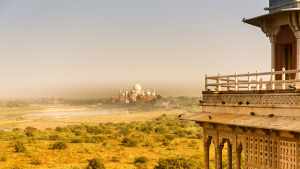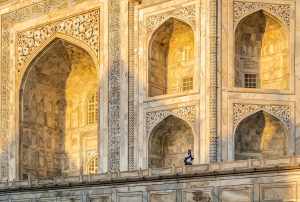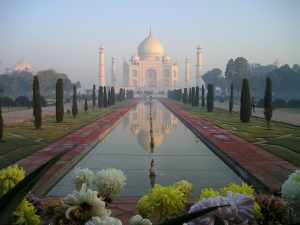Table of Contents
The Taj Mahal stands strong as a symbol of love. Carved to perfection using white marble and red sandstone, the Taj Mahal locates in Agra along the river Yamuna banks. The beautiful wonder of the world was erected by the Mughal ruler Shah Jahan. The emperor had built the monument for his deceased spouse, Arjumand Bano Begum. The mahal is also known as Mumtaz Mahal, after another name of his wife. Here, we will know all about the history of the Taj Mahal.
Even to this date, the Taj Mahal is believed to be the epitome of beauty and love. The universally celebrated and admired monument has acquired a place among the seven wonders in the world. It has also been declared a World Heritage Site by UNESCO. The area attracts millions of tourists from all across the globe throughout the year. However, the history of the Taj Mahal throws light on various aspects of the monument.
History of the Taj Mahal
The history of the Taj Mahal dates back to 1631. The monument depicts the purity of Shah Jahan’s love for his wife. Mumtaz Mahal, the beloved companion of Shah Jahan, breathed her last in the year 1631 while giving birth to the fourteenth child. Before her death, Mumtaz Mahal expressed four of her wishes to her husband. She pleaded to him to build a magnificent tomb for her, asked him to remarry, be kind to their children, and lastly, she requested him to pay a visit to her grave each year on the day of her demise.
His beloved wife’s sudden demise had affected Shah Jahan so severely that all his hair and beard began to turn grey. Famous poet Rabindranath Tagore called the Taj Mahal “a teardrop on the cheek of time.” The monument is an eternal symbol of romance. The beauty of the memorial is how perfectly it was embellished with precious stones and jewels. The architecture and excellent craftsmanship are praiseworthy. The monument is the best way that Shah Jahan could pay tribute to his deceased wife.
Shah Jahan could not keep his promise of paying a visit to his beloved wife on her death anniversary, because his son, Aurangzeb, had held him captive in his own house. It is believed that during his captivity, Shah Jahan used to lie in bed and gaze at the Taj Mahal through a diamond that was carefully placed in a particular angle!

Well-planned building
According to the history of Taj Mahal, Bibadal Khan, a poet, and a goldsmith had uttered the words, “May the abode of Mumtaz Mahal be paradise.” Shah Jahan left no stone unturned to give fulfillment to this statement. He wanted to build something extraordinary for his deceased wife, so he assigned the finest craftsmen to work on the Taj Mahal construction.
It is a well-planned building which has a perfect symmetry. While marble and brick-in-lime mortar coupled with red sandstone was used to make the exterior, the interiors were ornamented with precious and precious stones of different shades. The use of white and red stones in the construction of the Taj Mahal has a symbolic significance. The use of white stone was confined to the Brahmins and red stone to the Kshatriyas. Thus, using both in the construction, the Mughal emperor asserted his authority over both the races.
The arches and the frames have floral designs, which were quite significant during the era. Men worked untiringly for twenty-two years and gave vent to this heavenly beauty.
Brilliance of architecture
Sheer evidence of the Indo-Islamic architecture’s brilliance and the Taj Mahal’s fine craftsmanship deserves a notable mention while speaking of the Taj Mahal history. The interior and the texture of the monument have a rhythmic amalgamation of voids and solids, light and shadow, domes and arches, etc. The color combination adds to the aesthetic value of the building.
The monument reflects the color of the sky and changes its hue multiple times a day. The river Yamuna also adds to this exotic color-play. While it has a pinkish tinge during the day, it appears golden when the moonlight falls on it. It is believed that the Taj Mahal looks the best on a moonlit night. The reddish pathway emerging distinctly from the lush-green scape enhances the beauty of the monument. The intricate work with different kinds of stones, both precious and semi-precious, imparts an exotic magnificence to the mausoleum.

Basic structure of The Mausoleum
Digging into the Taj Mahal history, one can find that the monument is an outcome of skilled and experienced craftsmanship. The memorial planning includes finding a perfect spot for placing the tomb. The monument is not at the exact center of the garden. This helps to add depth and perspective to the monument when viewed from a distance. The tomb is raised and built on a square-shaped platform that has four minarets at the edges. The minarets enhance the three-dimensional view of the Taj.
The minarets have been positioned in a way, so that if they rupture due to a natural calamity, it will fall away from the main dome. One has to climb a flight of stairs to reach the top of the raised platform. The base has a symbolic significance. It signifies the different angles from which a woman, who possesses enchanting beauty, can be viewed.
Throwing light into the intricacies
The inference and comparison of a woman’s beauty have been drawn several times throughout the monument’s construction. For instance, the main gate has been made in a shape that resembles a woman’s veil, which reveals her beauty when slowly lifted. Similarly, as one enters through the main gate of the Taj Mahal, the beauty will be unveiled gradually, in a manner very similar to lifting the veil of a newly-wed Indian bride.
The monument has a screen of octagonal marble lattice that surrounds the cenotaphs. The mausoleum is richly decorated and has been very carefully polished to perfection.
The intricate designs are fascinating and have been executed wonderfully. The frames have borders that have beautiful floral designs carved on them. They are also embellished with precious stones. Stones of different hues and shades are used to make the flowers and the leaves, which impart a realistic appearance to them.
Cenotaphs of both Mumtaz Mahal and Shah Jahan are placed next to one another. The cenotaph of Shah Jahan was built almost 30 years after that of Mumtaz Mahal was built. However, the visible upper part of the cenotaphs is illusionary. The real graves of the emperor and the empress lie much lower.
Element of optical illusion
The Taj Mahal was designed in a way so that it could provide a rich and otherworldly experience. The craftsmen who were assigned the task of building the Taj Mahal were experts in an optical illusion. They experimented a great deal with it. Apart from the four minarets, another evidence of optical illusion can be witnessed at the monument’s main gate. As you enter through the main entrance of the Taj Mahal, the monument appears bigger and seems closer. As one approaches it, it begins to grow smaller in size. This helps to add a tinge of mystery to the place.
The Walls Of The Taj Mahal
The walls of the Taj Mahal are beautifully embellished with calligraphy. This enriches the holy aura of the place. The inscriptions carved on the Taj Mahal walls have meaning and evoke a sense of reward and judgment.
Another eye-catching decorative element used in the walls of the Taj Mahal is the Pietra Dura. Pietra Dura refers to nothing but the use of stones for embellishment. The floral designs are also significant to note. It unveils the fact that anthropomorphic characters were considered condemnable in the Islamic culture. Therefore, the use of any human character was consciously eliminated. The mosaic work has been done on the walls so carefully that it strikes the visitors’ immediate attention. The floral and vegetable motifs, abstract art, mosaic work, and murals fill the place with enchanting beauty.
Not only this, but the flowers used in the decoration of the interior of the Taj Mahal behold a special symbolic significance. Nearly forty-six different species of flowers have been used for embellishment. For instance. The lotus signifies purity, eternity, and rebirth; tulip signifies love, and cypress symbolizes strength. The vegetable and floral motifs have been chosen very carefully and evoke images and aura of heaven. They have a common theme of calm and eternal life.
Significance of the Dome
The dome is an essential element that is a significant part of Mughal architecture. It is found in a large number of monuments. The dome of the Taj Mahal is an example of a Persian dome. The structure has two domes- an outer dome which is supported by an inner dome. There is a space between the two domes. This double dome technique imparts a visually aesthetic appeal and helps the onion bulb retain proportions. The double dome is symbolic of the heavenly abode of a deceased soul.
The Reflection Pool
Even before one sees the majestic mausoleum, the brilliant white marble’s reflection against the clear blue sky on the still water of the reflection pool is sure to draw one’s attention. The thought is to purify the visitor’s vision before he steps into the magnificent edifice. The pool gives a magical appeal to the monument. It is an ideal place for the photographers to click spellbinding photographs!

The Importance of the Garden
In Islamic culture, the garden concept was derived from Islamic texts that described paradise as a place filled with flowers, plants, and trees. Water also played a significant role in this belief. According to the Islamic culture, the river flows from a central point and runs towards the mountain. This idea has been skillfully depicted in the Taj Mahal.
As a memorial for a deceased person, the Taj Mahal incorporates all the elements emblematic of paradise. The lush green garden is not only symbolic of heaven but also is visually soothing. The lake is arranged in order and is divided into four parts. This represents the four rivers of paradise. At the center, there is a structure of a fountain made out of marble. However, certain contradictions exist about the tomb’s angular positioning and the pond, which defy the standard Mughal or Islamic norms.
The Myth of Black Taj Mahal
There is a popular myth that encircles this grand edifice. Legend has it that emperor Shah Jahan desired to build a replica of the Taj Mahal on the opposite side of the river Yamuna. This monument was to be made out of black marble. This was to be used as his mausoleum. He had even started constructing the black Taj Mahal but could not complete it as he was held captive by his son, Aurangzeb. Even to this date, people are intrigued by the presence of the black Taj Mahal.
Threats faced by the Taj Mahal
As times are passing, the glory of the history of Taj Mahal is fast disappearing! In Agra, the levels of pollutants in water and air goes high due to rapid industrialization and other human activities. This is a considerable threat to this grand edifice. The dazzling white marble is gradually losing color and turning pale. Specialists now find cracks in the monument. Moreover, the four minarets are also believed to have tilted slightly.
The Taj Mahal is one of the Seven Wonders of the World. It is not just an emblem of romance and beauty but also upholds the rich cultural heritage of India. We must preserve the monument and make sure that it lasts. The grandeur and elegance must not fade even an inch from what we see it today.
If you ever visit India, you know where to book your flights to at first. Agra is close to the capital city of Delhi. You can easily book flights to Delhi and plan a road trip to visit this beauty.









